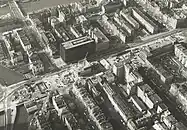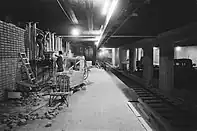Weesperplein metro station
Weesperplein is an underground metro station in the city centre of Amsterdam, Netherlands. Served by lines 51, 53 and 54 of the Amsterdam Metro, the station was constructed using caissons with a length and width of 40 metres (130 ft). The station has two floors, the upper floor featuring a station hall with stores and the lower floor containing the tracks. Construction at Weesperplein started in August 1970. The first test rides passed through the station in January 1977. Extensive tests were carried out in September that year before the station opened on 16 October.
Weesperplein | |||||||||||||||||||
|---|---|---|---|---|---|---|---|---|---|---|---|---|---|---|---|---|---|---|---|
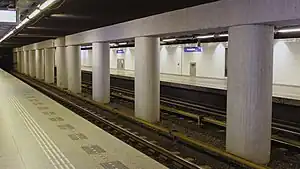 Track level of the metro station | |||||||||||||||||||
| General information | |||||||||||||||||||
| Location | Weesperplein, Amsterdam | ||||||||||||||||||
| Coordinates | 52°21′41″N 4°54′28″E | ||||||||||||||||||
| Owned by | Gemeente Vervoerbedrijf | ||||||||||||||||||
| Line(s) | 51, 53, 54 (Metro) | ||||||||||||||||||
| Platforms | 2 | ||||||||||||||||||
| Tracks | 2 | ||||||||||||||||||
| Connections | |||||||||||||||||||
| Other information | |||||||||||||||||||
| Fare zone | 5700 (Centrum) | ||||||||||||||||||
| History | |||||||||||||||||||
| Opened | 16 October 1977 | ||||||||||||||||||
| Rebuilt | 2017–2018 | ||||||||||||||||||
| Services | |||||||||||||||||||
| |||||||||||||||||||
Another platform below the existing one was built as the station was originally planned to be the intersection point of two lines. This platform was instead used as a fallout shelter with a capacity of 5,000 people when the majority of the network was cancelled in 1975 following protests against the destruction of houses. The shelter was not maintained from 1999 onwards and equipment was removed in 2004 to make way for smoke extraction machinery.
Repairs conducted at the station during a renovation in 2011 were of poor quality and had to be redone. Weesperplein was renovated again during 2017 and 2018, when a new elevator and two more staircases between the hall and tracks were constructed. It was the fifth most used station of the Amsterdam Metro in 2018.
Layout
Weesperplein and other metro stations on the East Line were designed by two architects from the Government of Amsterdam: Ben Spängberg and Sier van Rhijn.[1] The station is located under Weesperstraat[2] and consists of two underground levels. The top level has eight entrances from the streets[3] and includes the paygates of the metro system and some stores such as an Albert Heijn To Go convenience store[4] and a sandwich shop.[5] The level below is where the metro tracks are located and has two side platforms. All other metro stations on the East Line have an island platform, but an exception was made for Weesperplein as it was supposed to be a station where two lines would intersect,[6] which also resulted in a larger station hall.[7] The rest of the metro system runs on double-track; Weesperplein is the only station to have a third reserve track in between those two. This track can be used in case of an emergency.[8] In 2018, bicycle parking racks outside one of the entrances were replaced by flowers.[9]
Ghost station and shelter
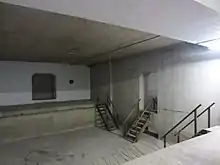
In Weesperplein, planners had to consider the possibility of an additional East–West Line.[10] Since the second line was almost guaranteed to be built at the time, the decision was made to start work on the bottom platform in advance as building it afterwards would have been too complicated.[11] An extra area below the platform used by the East Line was created, which consisted of large open areas made out of concrete.[12] This area only had the space to fit in an island platform, as columns supporting the entire station structure above limited the size of the tunnel. In the original plan, the line would have run under houses and caused their demolition.[11]
After the East–West Line was cancelled by the municipality on 19 March 1975,[13] the area was converted to be used as a fallout shelter.[12] The whole station has a capacity to house up to 12,000 people,[14] 5,000 of them inside the shelter.[15] The shelter included beds, water tanks, and garbage chutes for disposing of radioactive clothing.[16] There are showering areas at the very bottom with bulkheads, but the shower heads and disposal systems were removed later.[15] The doors are watertight and undergo annual testing to ensure functionality. Public shelters in Amsterdam, including the shelter at Weesperplein, were not maintained from 1999 onwards.[16] In 2004, the equipment was removed to make way for smoke extraction machinery in case of a fire.[12] The former shelter can be accessed via sliding doors at the top level of the station.[15]
History
Background

The Bureau Stadsspoor (City Track Bureau) was formed in 1963 following a 1960 report and concluded that Amsterdam needed a new rail system to move large numbers of people. The bureau released five reports by 1966 and laid out a final plan for a total of four metro lines in the city, which was presented to the public in the same year during a press conference by alderman Roel de Wit.[17] The plan included two East–West lines, which would intersect each other twice: at Looiersgracht[18] and at Weesperplein.[19] The municipal council and the mayor of Amsterdam came together in April 1968 to debate on the metro. A month later, the council approved the plans based on the advice of the bureau and reserved 5 million Dutch guilder for the design of the eastern branches of the two East–West lines, which was the first phase of the project.[17] Expectations were that the lines would be running within five years and that the total cost would be around 250 million guilder.[19]
Construction
Weesperplein was the first Amsterdam Metro station to begin construction, work commencing in August 1970. It was expected to take 4 to 5 years to finish the station.[20] Most underground areas of the East Line were constructed by using caissons, which made pumping out groundwater unnecessary. The caissons were built above ground on-site, and generally had a length of 40 metres (130 ft) and a width of 10–18 metres (33–59 ft). At Weesperplein these were 40 metres wide, even wider than those at Amsterdam Centraal, which were 30 metres (98 ft). The earth below the caissons was rinsed with water and pumped out, allowing the caissons to be lowered into place.[21] There were protests against the construction of the metro, as this method required the demolition of the houses above the line.[22] A tram stop with multiple amenities dating back to 1923 had to be destroyed for the metro.[23]
The station was reported to be almost complete by June 1974; operations were expected to start years later.[24] During the process of digging the station, two former freshwater storage basements were found. In the city centre of Amsterdam within the Singelgracht are 33 of these basements, but not much is known of them as they have not been in use since the mid-19th century.[25]
Opening and early years

A train was first rolled into the underground tunnels by the Gemeente Vervoerbedrijf (GVB) on 25 January 1977, and mayor Ivo Samkalden drove the metro under supervision.[26] The section from Weesperplein to Amsterdam Centraal was not completed yet at the time.[27] Before the public opening, journalists and members of the municipality council were given a ride from Amsterdam Amstel to Weesperplein.[28]: 0:23–0:38 Testing of regular metro operations started in late August 1977, after training of staff was completed.[29]
The metro line, including Weesperplein station, opened to the public on 16 October.[30] For the first few years, Weesperplein was the terminus of the system: trains that came into the station were turned around with a switch that was located just after the station and ran the other direction towards Bijlmermeer.[28]: 1:33–1:41 At Bijlmermeer the line split into two, one line ending at Gaasperplas and the other at Holendrecht. The section towards Centraal station was opened later on 11 October 1980 and Weesperplein was no longer a terminus for the two lines.[31] Braille patterns were installed on the handrails at the station in 1984 to assist blind and visually impaired people.[32]
In 1990, a tram-metro hybrid named sneltram (high-speed tram) started operations as line 51. Using special trains, the metro line would convert into a high-speed tram line at Amstelveen and run alongside regular trams.[33][34] A high-speed tram caught fire at the Weesperplein station on 12 July 1999 due to a blocked disc brake. Although the tram was carrying no passengers at the time, the smoke coming from the fire caused all levels of the station to be evacuated.[35] Two people were taken to hospital for smoke inhalation, but were discharged quickly after their injuries were determined to be minor.[36]
2010s
During a 2011 renovation, asbestos was found in one of the emergency stairs of the station, which prevented metro operations for another two months. An internal review of the renovation found that the quality of repairs fell short of standards and that these had to be redone regularly.[37] In 2014, an exact replica of the station was built in Vught, North Brabant, to enable police, first aid, firefighting, and military personnel to train for emergency situations.[38] The GVB started to play music through the speakers of underground metro stations in April 2017 as a test. The type of music would depend on the time of day: slow and calming music during rush hours, and energetic music during the afternoon.[39]
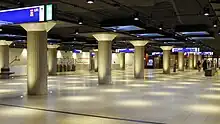
A renovation of the station started in May 2017 with one of the entrances. The renovation was split into five phases to allow the station to be kept open, each phase taking three to four months. Concrete was replaced with glass to make it seem lighter and more spacious.[40] As the payment gates located before the stairs from the hall to the platform frequently caused congestion on the platform due to passengers not being able to leave quickly, they were moved to the actual station entrances, creating one large central hall.[41] A new elevator from the hall to the platforms was constructed, and the three existing ones were renovated. Two new staircases to the tracks were also built. Supply of new and disposal of old material was done by using the rails at night, when the Amsterdam Metro does not run. This was done to avoid creating traffic jams above ground.[42] Walls were given smooth curves to direct passengers.[7]
Writing for Het Parool, Marc Kruyswijk commented that before the renovations, the station was a place "where you would prefer to spend as little time as possible," but after the renovation, it "suddenly looked as if it was not only a part of the past but also a part of the present".[43] The same newspaper had previously called it an "underground labyrinth" where travellers had difficulties in finding the exits.[44] In 2018, Het Parool reported that the station was already somewhat done in case a new East–West Line was planned. This would make Weesperplein a station where travellers could connect from one line to the other, as originally intended in the 1970s.[45] Weesperplein was the fifth most used station of the Amsterdam Metro in 2018 with 36,373 passengers per day, behind Amsterdam Centraal, Amsterdam Zuid, Amsterdam Amstel and Amsterdam Bijlmer.[46]
Artwork

Artists were invited by officials to create artwork for most stations, but Weesperplein and Bijlmer station had a public competition, where all Dutch artists were allowed to send their ideas.[47] Of the 198 submissions, three were selected to be placed in Weesperplein.[48]
Luchtspiegelingen by Matthijs van Dam is composed of 12 panels showing Weesperstraat and Sarphatistraat seen from below. The view of roads, cars and clouds gives the illusion of looking up through the station to the outside. The panels were placed on the ceiling at platform level in 1977 and were removed in 2010 due to fire safety concerns. They were reinstalled eight years later, this time on the ceiling of the station hall.[49] Verplaatsing by Charles Bergmans is ten square pieces of hard rocks. Located in the station hall, travelers could sit on them, which made their surfaces smooth and shiny over the years.[48] Signatuur van de anonieme arbeider by Pieter Engels is three bronze beams forming the letter A. The beams symbolize the three groups that made the metro possible: Amsterdam, contractors and workers (Dutch: Amsterdam, aannemer en arbeider).[50]
Services
The station is served by metro lines 51, 53 and 54. North-bound, all three lines use the same track and end at Amsterdam Centraal. South-bound, M53 ends at Gaasperplas, and M54 ends at Gein.[51] The tram-metro hybrid line M51 used to serve the Amstelveen suburb by heading south after Amsterdam Zuid and end at Westwijk, but the section after Zuid was closed in 2019 and replaced by an actual tramline.[33] M51 now continues west-bound after Zuid and ends at Isolatorweg as a full metro line.[52] A tram stop near the entrance of the metro station with the same name is served by tram lines 1, 7 and 19.[53] In the early rush hour, bus 246 runs twice in one direction towards Schiphol–Zuid.[54] At night, night buses N85 and N86 stop near the station.[55]
References
Citations
- Margreet Bosma (13 November 2012). "Twaalf jaar lang aan de ontwerptafel van de Oostlijn– deel 2" [12 years on the drawing board of the East Line– part 2]. Wij Nemen Je Mee (in Dutch). Government of Amsterdam. Archived from the original on 28 October 2022. Retrieved 28 October 2022.
- Jaap Huisman (27 January 2017). "Station Noorderpark: vernuft, als een cobra" [Noorderpark station: ingenuity, like a cobra]. Het Parool (in Dutch). Archived from the original on 22 September 2022. Retrieved 21 September 2022.
- Tahrim Ramdjan (9 May 2022). "Waarom vinden we de stations Lelylaan en Muiderpoort zo onaangenaam? 'Reizigers willen gezien worden'" [Why do we find the Lelylaan and Muiderpoort stations so unpleasant? 'Travellers want to be seen']. Het Parool (in Dutch). Archived from the original on 9 May 2022. Retrieved 25 September 2022.
- Charlotte de Vries (19 December 2022). "Deze supermarkten in Amsterdam zijn gesloten tijdens de kerst" [These supermarkets in Amsterdam are closed during Christmas]. In de buurt (in Dutch). Archived from the original on 22 April 2023. Retrieved 22 April 2023.
- Dan Afrifa (17 October 2022). "Trek en onderweg? Stap dan uit bij deze metrostations" [Hungry and on the go? Then get off at these metro stations]. Het Parool (in Dutch). Archived from the original on 17 October 2022. Retrieved 17 October 2022.
- "Een tocht in de buis" [A journey in the tube]. Het Parool (in Dutch). 13 February 1976. p. 4. Retrieved 22 January 2023 – via Delpher.
- van Bremen, van Erp & Lever 2020, p. 130.
- van Vollenhoven 2000, p. 10.
- Hans van Lissum (21 May 2018). "Zelfs op het rauwe Weesperplein bloeien straks bloemetjes" [Even on the raw Weesperplein, flowers will soon bloom]. Het Parool (in Dutch). Archived from the original on 22 September 2022. Retrieved 21 September 2022.
- Marc Kruyswijk (28 February 2018). "Krijgen we na de Noord/Zuidlijn ook de Oost/Westlijn?" [After the North–South line, will we also get the East–West Line?]. Het Parool (in Dutch). Archived from the original on 30 June 2022. Retrieved 30 June 2022.
- Duco Vaillant (13 December 2017). "Het eerste Oost/Westlijn-station bestaat al..." [The first East–West Line station already exists...]. Wij Nemen Je Mee (in Dutch). Government of Amsterdam. Archived from the original on 24 January 2023. Retrieved 18 May 2023.
- Renske van Bers (6 November 2012). "35 jaar Oostlijn: Oud-ingenieur Joop Verkamp over de aanleg van de atoombunkers" [35 years of the East Line: Former engineer Joop Verkamp on the construction of the nuclear bunkers]. Hier Zijn Wij Nu (in Dutch). Government of Amsterdam. Archived from the original on 18 February 2014.
- Ouwendijk 1977, p. 14.
- Jorien van der Keijl (6 May 2017). "Schuilkelders in Amsterdam: Opslagruimte, fietsenhok of gewoonweg gesloopt" [Air raid shelters in Amsterdam: Storage space, bicycle shelter or simply demolished]. Het Parool (in Dutch). Archived from the original on 4 September 2020. Retrieved 25 September 2022.
- Marc Kruyswijk (19 March 2022). "'Niet bestand tegen een voltreffer': dit zijn de Amsterdamse schuilkelders uit de Koude Oorlog" ['Not resistant to a direct hit': these are the air raid shelters of Amsterdam from the Cold War]. Het Parool (in Dutch). Archived from the original on 20 March 2022. Retrieved 25 September 2022.
- van der Hee 2017, p. 20.
- Ouwendijk 1977, pp. 12–13.
- Bureau Voorlichting van de Gemeente Amsterdam 1968, p. 6.
- Bureau Voorlichting van de Gemeente Amsterdam 1968, p. 1.
- "Volgende week begint bouw eerste metro station" [Construction of the first metro station will start next week]. De Waarheid (in Dutch). 20 August 1970. p. 1. Retrieved 22 January 2023 – via Delpher.
- Ouwendijk 1977, pp. 27–28.
- Marc Kruyswijk (16 October 2017). "40 jaar metro: 'Zonder zou Amsterdam zijn vastgelopen'" [40 years of metro: 'Amsterdam would have come to a standstill without']. Het Parool (in Dutch). Archived from the original on 22 September 2022. Retrieved 21 September 2022.
- Erik Klein Wolterink (9 May 2023). "Zoek de verschillen: Weesperplein in 1926 en 2023" [Find the differences: Weesperplein in 1926 and 2023]. Het Parool (in Dutch). Archived from the original on 18 May 2023. Retrieved 18 May 2023.
- "Amsterdams Metrostation" [Metro station of Amsterdam]. De Volkskrant (in Dutch). 27 June 1974. p. 8. Retrieved 22 January 2023 – via Delpher.
- Ouwendijk 1977, p. 62.
- Ouwendijk 1977, p. 18.
- "Amsterdamse metro gaat dit najaar rijden" [The Amsterdam metro will start running this fall]. Algemeen Dagblad (in Dutch). 4 February 1977. p. 7. Retrieved 22 January 2023 – via Delpher.
- "Amsterdamse Metro voor het eerst ondergronds" [Amsterdam metro underground for the first time]. Polygoon (in Dutch). 1977. Archived from the original on 22 September 2022. Retrieved 20 September 2022 – via Netherlands Institute for Sound and Vision on YouTube.
- "Omstreden metro gaat nu van start" [Controversial metro will now start]. Nieuwsblad van het Noorden (in Dutch). 8 October 1977. p. 27. Retrieved 15 April 2023 – via Delpher.
- Manenschijn, Smit & Beens 2007, p. 17.
- "Metrolijn maakt geschiedenis" [Metro line makes history]. Het Parool (in Dutch). 10 October 1980. p. 5. Retrieved 22 January 2023 – via Delpher.
- "Wegwijzers voor blinden bij metro" [Signage for the blind at metro]. Algemeen Dagblad (in Dutch). 26 June 1984. p. 5. Retrieved 22 January 2023 – via Delpher.
- Quintus Vosman (5 March 2019). "Dutch start reconstruction of Amstelveen LRT". International Railway Journal. Archived from the original on 21 March 2019. Retrieved 20 September 2022.
- van Vollenhoven 2000, p. 16.
- van Vollenhoven 2000, pp. 8–9.
- van Vollenhoven 2000, p. 15.
- de Ridder 2016, pp. 59–61.
- Tim Reedijk (30 September 2014). "Defensie plaatst exacte kopie metrostation in bossen Vught" [The Ministry of Defense places an exact copy of a metro station in the woods of Vught]. Algemeen Dagblad (in Dutch). Archived from the original on 22 April 2023. Retrieved 20 September 2022.
- "Proef met muziek op metrostations" [Test with music in metro stations]. Het Parool (in Dutch). 25 April 2017. Archived from the original on 22 September 2022. Retrieved 21 September 2022.
- "Renovatie station Weesperplein van start" [Renovation of Weesperplein station has started]. Het Parool (in Dutch). 15 May 2017. Archived from the original on 7 October 2022. Retrieved 7 October 2022.
- van Bremen, van Erp & Lever 2020, p. 131.
- Marlo de Kat (18 July 2018). "Renovatie station Weesperplein: complex met een harde einddatum" [Renovation of Weesperplein station: complex with a solid deadline]. Wij Nemen Je Mee (in Dutch). Government of Amsterdam. Archived from the original on 28 February 2021. Retrieved 20 September 2022.
- Marc Kruyswijk (13 December 2018). "De Oostlijn is niet meer het lelijke eendje van de metro" [The East Line is not the ugly duckling of the metro anymore]. Het Parool (in Dutch). Archived from the original on 21 September 2022. Retrieved 21 September 2022.
Weesperplein, Waterlooplein en zelfs Van der Madeweg: ze zien er ineens uit alsof ze niet meer alleen van vroeger zijn, maar ook een beetje van nu.
- Jaap Huisman (27 January 2017). "Station Noorderpark: vernuft, als een cobra" [Noorderpark station: ingenuity, like a cobra]. Het Parool (in Dutch). Archived from the original on 22 September 2022. Retrieved 21 September 2022.
Een station als Weesperplein bleek te veel een ondergronds labyrint, waar de reiziger slechts met moeite de uitgang wist te vinden.
- Marc Kruyswijk (22 July 2018). "Nu is het tijd voor de Oost/Westlijn" [Now it's time for the East–West Line]. Het Parool (in Dutch). Archived from the original on 21 September 2022. Retrieved 21 September 2022.
- Duco Vaillant (19 February 2019). "Top 10 drukste metrostations van Amsterdam" [Top 10 busiest metro stations of Amsterdam]. Wij Nemen Je Mee (in Dutch). Government of Amsterdam. Archived from the original on 16 October 2021. Retrieved 20 September 2022.
- Ouwendijk 1977, p. 51.
- "Verplaatsing". Metrokunst (in Dutch). Government of Amsterdam. Archived from the original on 7 October 2022. Retrieved 7 October 2022.
- "Luchtspiegelingen". Metrokunst (in Dutch). Government of Amsterdam. Archived from the original on 7 October 2022. Retrieved 7 October 2022.
- "Signatuur van de anonieme arbeider". Metrokunst (in Dutch). Government of Amsterdam. Archived from the original on 7 October 2022. Retrieved 7 October 2022.
- Manenschijn, Smit & Beens 2007, p. 29.
- "Metro 51". Gemeente Vervoerbedrijf (in Dutch). Archived from the original on 27 January 2022. Retrieved 20 September 2022.
- "Halte Weesperplein". Gemeente Vervoerbedrijf (in Dutch). Archived from the original on 22 October 2021. Retrieved 20 September 2022.
- "Halte Weesperplein". Gemeente Vervoerbedrijf (in Dutch). Archived from the original on 12 February 2023. Retrieved 6 May 2023.
- "Halte Weesperplein". Gemeente Vervoerbedrijf (in Dutch). Archived from the original on 12 November 2022. Retrieved 12 November 2022.
Bibliography
- van Bremen, Maarten; van Erp, Jeroen; Lever, Maarten (2020). Metro Oostlijn Amsterdam: Designing the system. Lecturis. pp. 130–133. ISBN 9789462262706.
- Bureau Voorlichting van de Gemeente Amsterdam (1968). "Amsterdamse Metro Kan Over Vijf Jaar Rijden" [Amsterdam Metro Can Run in Five Years] (PDF) (in Dutch). Archived from the original (PDF) on 7 December 2016. Retrieved 28 October 2022.
- van der Hee, Sterre (September 2017). "Als De Bom Valt" [When The Bomb Falls]. Folia (in Dutch). Vol. 69, no. 2. University of Amsterdam. pp. 14–20. ISSN 0166-0136. Archived from the original on 25 September 2022. Retrieved 25 September 2022.
- Manenschijn, Henk-Jan Jansen; Smit, Hans; Beens, Arnoud (June 2007). Metronetstudie [Metro network study] (PDF) (Report) (in Dutch). Government of Amsterdam. Archived (PDF) from the original on 22 February 2022. Retrieved 20 September 2022.
- Ouwendijk, Cees (October 1977). Een metro in Amsterdam [A metro in Amsterdam] (PDF) (in Dutch). Gemeente Vervoerbedrijf. Archived (PDF) from the original on 20 September 2022. Retrieved 20 September 2022.
- de Ridder, Jan; et al. (January 2016). Renovatie Oostlijn [Renovation East Line] (PDF) (Report) (in Dutch). Rekenkamer Metropool Amsterdam. Archived (PDF) from the original on 30 August 2019. Retrieved 20 September 2022.
- van Vollenhoven, Pieter; et al. (July 2000). Fire in High-speed Tram (PDF) (Report). Dutch Transport Safety Board. Archived (PDF) from the original on 12 July 2022. Retrieved 21 September 2022.
External links
- Official website (in Dutch)
